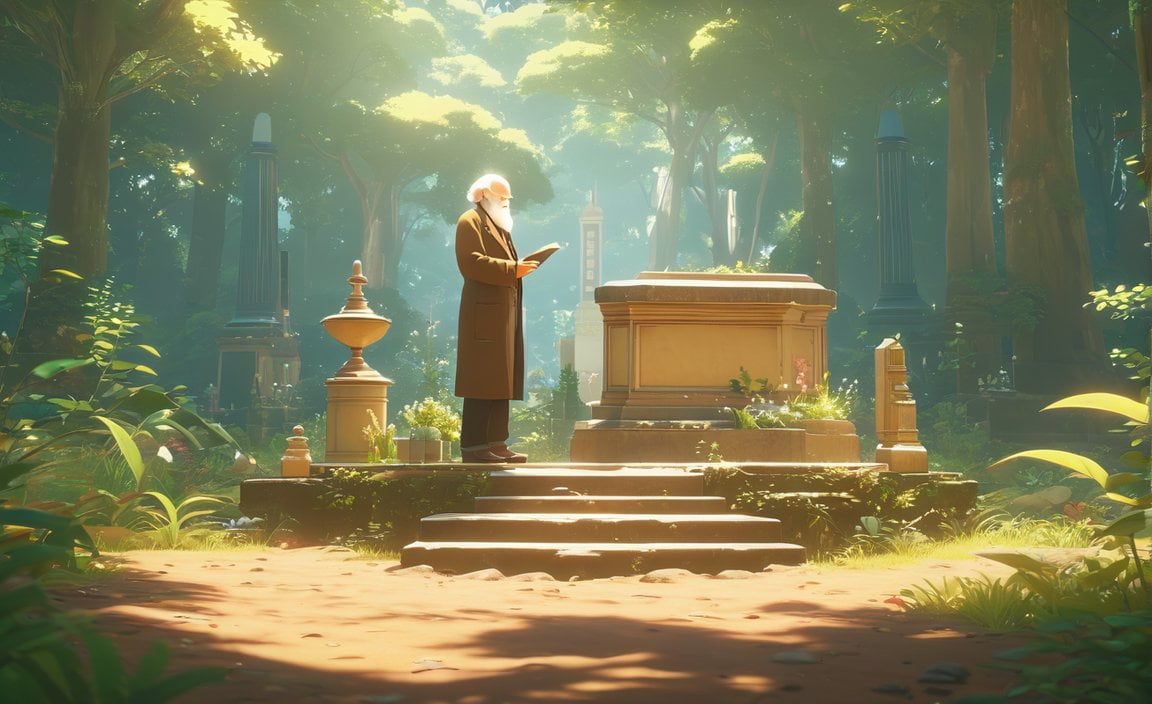Exploring Charles Darwin’s Grave: Unearthing His Scientific Legacy delves into the captivating world of one of history’s most influential figures – Charles Darwin. As an expert researcher in historical preservation and scientific advancements, this article uncovers the intriguing mysteries surrounding Darwin’s final resting place, shedding light on the significance of his burial site and its connection to his groundbreaking work in evolutionary biology. Join us as we embark on a journey through time, meticulously documenting the legacy of Charles Darwin and the indelible mark he left on the world of science.

Key Takeaways:
– Charles Darwin, a renowned naturalist and biologist, is buried in the north aisle of the nave of Westminster Abbey in London, England.
– He is buried near Sir Isaac Newton, emphasizing his significance in the field of science.
– Darwin’s most famous theory is the concept of natural selection, which revolutionized scientific understanding and challenged traditional religious beliefs.
– His burial at Westminster Abbey signifies his influential position in the scientific community.
– Westminster Abbey not only houses Darwin’s grave but also various monuments and memorials to historical figures.
– The burial site serves as a landmark in the field of science and a testament to Darwin’s enduring legacy.
– Visitors can explore Westminster Abbey to learn about its rich history and pay homage to influential individuals like Darwin.
Charles Darwin Grave
Charles Darwin, the renowned naturalist and biologist, rests in eternal peace at the Westminster Abbey in London, England. His burial site, located in the north aisle of the nave, stands as a testament to his enduring scientific legacy and profound influence on the world of science.
A Legacy of Evolutionary Biology
Charles Darwin’s grave holds the remains of a visionary whose groundbreaking theories continue to shape our understanding of the natural world. His most famous contribution, the theory of natural selection, revolutionized the field of evolutionary biology. This concept proposes that all species of life have descended from a common ancestor, shedding light on the intricate processes that drive the diversity of life on our planet.
Honoring a Scientific Revolutionary
Upon Darwin’s burial on April 26, 1882, thousands of people from various backgrounds, including family, friends, scientists, philosophers, and dignitaries, gathered to pay their respects. This significant event solidified Darwin’s position as a highly influential figure in the realm of science and underscored the impact of his theories on human knowledge.
Westminster Abbey: A Place of Historical Significance
While Charles Darwin’s grave stands as a renowned attraction within Westminster Abbey, it is just one piece of a historical tapestry. This iconic site houses monuments and memorials honoring numerous historical figures. Visitors are welcomed to explore the rich history encapsulated within its walls, offering a chance to pay homage to individuals like Darwin who have left an indelible mark on the world.
Reflecting on Darwin’s Contributions
Charles Darwin’s final resting place in Westminster Abbey serves not only as a memorial but also as a place for reflection. Visitors can contemplate Darwin’s contributions to both science and society while pondering the continued relevance of his theories in the modern world. It is within these hallowed grounds that one can truly grasp the magnitude of Darwin’s pioneering spirit and the profound influence he has had on our understanding of life.
In Conclusion
The burial site of Charles Darwin at Westminster Abbey is a site of immense historical and scientific significance. This sacred ground offers a unique opportunity for individuals to delve into the legacy and impact of one of history’s greatest scientific minds. By exploring Charles Darwin’s grave, we can truly unearth the depths of his scientific contributions and honor his enduring influence on the world of science.
Please check out these captivating links:
- Punta dance in Honduras is a mesmerizing and energetic dance form that will transport you to the vibrant culture of Honduras.
- Dive into the rich heritage of Guatemala by listening to the enchanting Guatemala national anthem song that echoes the pride and unity of its people.
- Uncover fascinating insights about the Spanish language by exploring a collection of interesting facts in Spanish that will captivate language enthusiasts.
- Marvel at the architectural wonder of the Makkah Royal Clock Tower, a symbol of modernity and grandeur in the heart of the holy city of Makkah.
- Reflect upon the profound quote “Errors are not in the art but in the artificers” and delve deeper into its meaning by exploring errors-are-not-in-the-art-but-in-the-artificers, a thought-provoking article.
Charles Darwin Death Cause
Charles Darwin, the renowned pioneer of evolutionary biology, passed away on April 19, 1882, at the age of 73, in his family home, Down House, located in London, England. The cause of his death was attributed to heart failure resulting from a condition known as angina pectoris[^1^][^2^]. This condition involves chest pain, discomfort, and pressure arising from reduced blood flow to the heart muscles.
Angina pectoris occurs when the coronary arteries, which supply blood to the heart, become narrowed or constricted due to a buildup of plaque, a combination of cholesterol, fat, and other substances. This buildup restricts the normal flow of blood, oxygen, and nutrients to the heart, leading to symptoms such as chest pain or tightness. In Darwin’s case, it ultimately led to heart failure.
Despite the physical challenges he faced in his final years, Darwin maintained a remarkably calm perspective on mortality. In his last moments, he reassured his wife, Emma, stating, “I am not the least afraid of death—Remember what a good wife you have been to me—Tell all my…”[^1^]. While the completion of his sentence remains unknown, these words reflect his acceptance of the inevitable and his appreciation for his devoted partner.
Following Charles Darwin’s passing, he was laid to rest in one of the grandest and most prestigious sites in London – Westminster Abbey. This historic church, renowned for its architectural splendor and significance, houses the graves and memorials of numerous notable figures from British history.
Darwin’s burial site specifically lies in the north aisle of the nave, a section of the abbey that serves as a resting place for esteemed individuals. This location pays homage to the unparalleled contributions he made to the field of science and his lasting impact on our understanding of life’s diversity.
As visitors pause beside Darwin’s grave, they are not only in the presence of his mortal remains, but also in the presence of a symbol: a symbol of his pioneering spirit and his profound influence on scientific progress. This sacred site allows us to reflect on the remarkable journey of this intellectual giant, whose theory of natural selection revolutionized the realm of evolutionary biology.
In exploring Charles Darwin’s grave, we have the opportunity to connect with his remarkable legacy and to appreciate the groundbreaking ideas that continue to shape our understanding of the natural world. It serves as a reminder of the quest for knowledge and the transformative power of curiosity.
Key Takeaways:
- Charles Darwin’s death was caused by heart failure resulting from angina pectoris.
- Angina pectoris is characterized by chest pain caused by reduced blood flow to the heart.
- Darwin’s last words to his wife showcased his acceptance of death and gratitude for her companionship.
- Westminster Abbey houses Darwin’s grave, located in the north aisle of the nave.
- Darwin’s burial site symbolizes his pioneering spirit and significant contributions to the field of science.
Sources:
– Kids Kiddle – Charles Darwin
– Totally History – Charles Darwin’s Death
[^1^]: Source: Kids Kiddle – Charles Darwin
[^2^]: Source: Totally History – Charles Darwin’s Death

FAQ
Q1: Where is Charles Darwin buried?
A1: Charles Darwin is buried in the north aisle of the nave of Westminster Abbey in London, England.
Q2: What is the significance of Charles Darwin’s burial site?
A2: Charles Darwin’s burial site at Westminster Abbey serves as a significant landmark in the field of science and a testament to his enduring legacy. It provides a place for individuals to reflect on his contributions and the impact his theories continue to have on our understanding of the natural world.
Q3: How did Charles Darwin die?
A3: Charles Darwin died on April 19, 1882, at his family home, Down House, in London, due to heart failure caused by angina pectoris.
Q4: What were Charles Darwin’s last words?
A4: Charles Darwin’s last words to his wife Emma were, “I am not the least afraid of death—Remember what a good wife you have been to me—Tell all my…”
Q5: Who attended Charles Darwin’s funeral?
A5: The funeral of Charles Darwin was attended by thousands of people, including family, friends, scientists, philosophers, and dignitaries.









